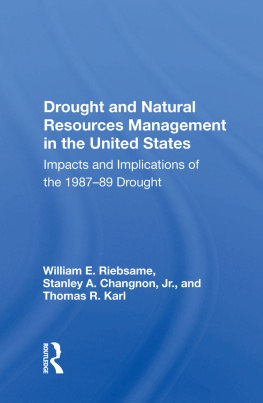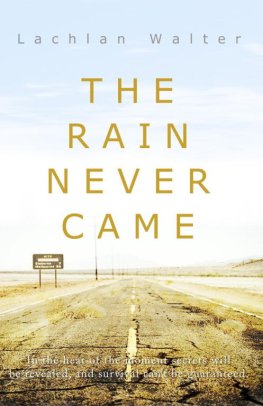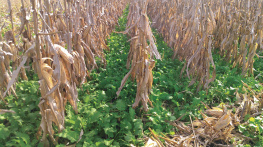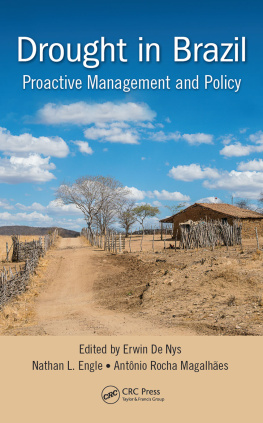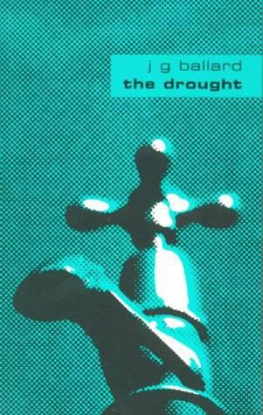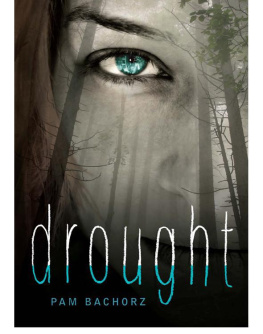Drought and Natural Resources Management in the United States
Drought and Natural Resources Management in the United States
Impacts and Implications of the 1987-89 Drought
William E. Riebsame, Stanley A. Changnon, Jr., and Thomas R. Karl
First published 1991 by Westview Press, Inc.
Published 2018 by Routledge
52 Vanderbilt Avenue, New York, NY 10017
2 Park Square, Milton Park, Abingdon, Oxon OX14 4RN
Routledge is an imprint of the Taylor & Francis Group, an informa business
Copyright 1991 Taylor & Francis
All rights reserved. No part of this book may be reprinted or reproduced or utilised in any form or by any electronic, mechanical, or other means, now known or hereafter invented, including photocopying and recording, or in any information storage or retrieval system, without permission in writing from the publishers.
Notice:
Product or corporate names may be trademarks or registered trademarks, and are used only for identification and explanation without intent to infringe.
Library of Congress Cataloging-in-Publication Data
Riebsame, William E.
Drought and natural resources management in the United States : impacts and implications of the 1987-89 drought / by William E. Riebsame, Stanley A. Changnon, Jr., and Thomas R. Karl.
p. cm. (WVSS in natural resources and energy management)
Includes bibliographical references and index.
ISBN 0-8133-8026-X
1. DroughtsUnited StatesManagement. 2. United States Climate. I. Changnon, Stanley Alcide. II. Karl, Thomas. III. Title. IV. Series.
QC929.D8R52 1991
363.3'492dc20
90-40603
CIP
ISBN 13: 978-0-367-01547-3 (hbk)
An endeavor such as this is not possible without many people's indispensable assistance. Valuable advice and reviews of draft material were provided by Peter LambIllinois State Water Survey, Mike HelpaU.S. Army Corps of Engineers, Alan HechtEnvironmental Protection Agency, and Don Despain and Phil PerkinsYellowstone National Park. Their help is greatly appreciated. Special thanks also go to Joyce Changnon for review and encouragement.
We take responsibility for the interpretation, conclusions, and recommendations, and our conclusions do not necessarily reflect those of the many agencies, such as the National Park Service, U.S. Army Coips of Engineers, U.S. Department of Agriculture, and National Oceanic and Atmospheric Administration, which played important roles in responding to the 1987-89 drought.
Special thanks go to Richard Heim of the National Climatic Data Center (NCDC), who is indeed a valuable national resource for climate information. Additional information was provided by Cameron JohnsonU.S. Forest Service Fire Sciences Laboratory, Dick ReinhardtWestern Regional Climate Center, Ken HubbardHigh Plains Climate Center, Ken KunkelMidwestern Climate Center, John PurvisSoutheastern Regional Climate Center, Warren KnappNorth-eastern Regional Climate Center, Moulton AveryCenter for Environmental Physiology, Dave MortonNatural Hazards Center, and James LaverClimate Analysis Center.
The research for the Mississippi and Atlanta case studies was conducted as part of the applied studies program of the Midwestern Climate Center, which is supported by NOAA/NCPO (Grant COMM NA8711-D-CP119) and state of Illinois funds.
The Yellowstone and North Dakota case studies were supported by the Natural Hazards Center, as was the overall editing and publishing process. David Diggs conducted the survey of North Dakota farmers reported in Bill Anderson and Eleanora Sabadell at NSF have been especially thoughtful and conscientious supporters of hazards research.
Scott Miller and Ronald Baldwin of the National Climatic Data Center and Dennis Ehmson of the University of Colorado Office of Contracts and Grants prepared most of the figures. Additional editorial assistance was provided by Elana Gallon and Wendy Hessler of the Institute of Behavioral Science, University of Colorado.
Finally, we owe many thanks to Sylvia Dane, Natural Hazards Center editor, for her hard work, good professional sense, and patience with this book. It would not have been published without her help.
William E. Riebsame
Stanley A. Changnon, Jr.
Thomas R. Karl
Notes
The center is funded by the National Science Foundation, the Federal Emergency Management Agency, the National Oceanic and Atmospheric Administration, the U.S. Geological Survey, the Tennessee Valley Authority, the U.S. Army Corps of Engineers, the Environmental Protection Agency, the National Institute of Mental Health, and the U.S. Department of Agriculture, Soil Conservation Service.
1
Introduction
The 1987-89 drought was a signal event in the evolving interrelationships among climate, natural resources management, technology, and society in the United States. Over half of the country experienced severe to extreme drought by midsummer of 1988 (). Losses upward to $39 billion illustrate the continuing, perhaps growing, vulnerability of many natural resources and economic sectors to drought and other climate fluctuations.
Despite decades of crop breeding, water system development, and other improvements in climate-sensitive technologies, the drought demonstrated that the simple lack of "normal" rainfall still provokes serious disruptions in agriculture, water supply, transportation, environmental quality, and other areas. It can affect the health and wellbeing of millions of people and evoke billions of dollars in government aid.
Several disturbing aspects of the drought presage continuing problems in the future. First, many natural resources managers were slow to recognize the significance of the event, and information on the drought's development and impacts was not disseminated and applied to critical decisions in a timely fashion. Natural resources managers often did not know how sensitive their systems were to drought, what impacts to expect from a severe drought, or the full range of options available for adjusting their activities. Despite a decade of growing interest in the social and economic impacts of climate fluctuations, codified in the 1979 National Climate Program Act, the nation remains ill-prepared to cope with unusual climate conditions.
The drought did evoke some successful responses, and lessons from past droughts were profitably applied in some cases. Indeed, those successes provide the rationale for this book: they indicate a greater potential for reducing drought impacts than was observed, especially during the height of the drought in 1988. By diagnosing this case, and placing it in the context of the evolving relationship between climate and society, we seek to point the way toward improved drought management in the future, as well as to better illuminate the path to reduced overall climate vulnerability.
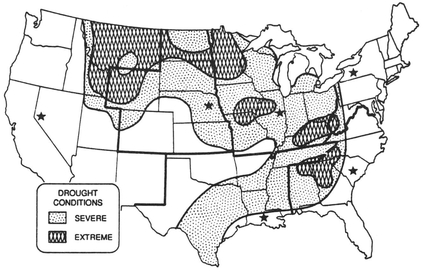
The drought's severity on June 15, 1988, as indicated by the Palmer Drought Severity Index ( Source: National Climatic Data Center)
The 1987-89 drought in the U.S. had several subtle effects on the way both the public and private sectors operate under conditions of climate stress and uncertainty. It raised the nation's consciousness about the role climate plays in the management of natural resources and illustrated how social vulnerability to natural hazards can change through time due to economic and policy changes. Finally, the link between the 1987-89 drought and longer-term climate change caused by the Greenhouse Effect, made by a few scientists and widely discussed by the news media, turned the drought into a symbol of potential climate disasters in the future.

